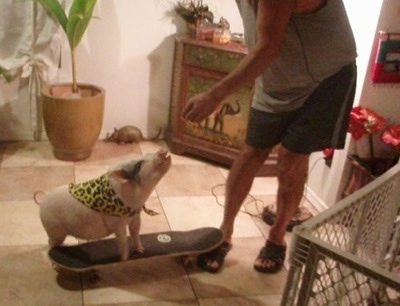
"This is Petunia, my pink pot-bellied pig at 8 months old. She skateboards, plays the piano, sits, lies down, waves and jumps through hoops. She walks on a leash, sleeps with the cat and is very sweet."
Original specimens brought to the United States in the 1980s were black. Now several varieties are available including grey, white, tan and red. Spotting (or ”pinto”) seems to be a preferred variation to many owners.
Pot-bellied pigs are small sized pigs suitable for indoor living if trained properly. Most range in size from 13-20 inches tall and can grow to approximately 200 lbs. They are curious animals with a humorous disposition and an intelligence only second to that of the dog. They are not finicky eaters and can be house trained.
Pot-bellied pigs became a pet of fashion in the United States in the early 1980s to mid-1990s. Unfortunately not many owners were educated adequately about the care and maintenance of a pot-bellied pig and many were abandoned in newly formed “pig sanctuaries” and “pig rescue” organizations. Since that time, much information has been published and organizations have been formed to give the desiring owner the adequate resources to keep their future pet healthy and maintained.
Temperament of your pet pot-bellied pig will vary. Males tend to be more aggressive and ”pigheaded” as they mature, especially if they are not neutered. Females can become territorial when they are pregnant. Most pigs will go through ”teenage” years as they mature. This stage is when they test their boundaries and see where they can put YOU in their pecking order. It is up to the owner to ensure that the pig learns its rightful place in the ”herd.” The owner should make the pig ”earn” his food and treats, thus enforcing the fact that the owner is the ”alpha.” During this phase the pig may develop ”selective” hearing and ignore commands from owners. It is up to the owner to consistently and uniformly enforce each action of the pig. If left uncorrected the pig may become unruly and this is, unfortunately, the time when most pigs are abandoned to shelters and rescues. It’s not the pigs fault; it is the lack of education on the owner’s part. Please be sure you are prepared for the responsibility of pet ownership before you purchase your pet. His life depends on you.
A mature pig will be approximately 13-20 inches tall, with an average weight being 130-150 pounds, but can range in size from 90–175. Overeating/overfeeding can lead to obesity in your pig, resulting in a weight well over 200 pounds.
There is no such thing as a “miniature pig” or a “tea-cup pig.” These animals are genetically bred to reduce their size. Do your research about the breeder before purchasing from someone who claims that they breed “miniatures,” etc. Most likely these are disreputable breeders with pigs that will likely show signs of inbreeding and genetic defect as they age, leading to an unhealthy, pain ridden pet.
Being outdoors also provides your pig with the ability to work off extra energy that they will not be able to do indoors. If they are left indoors with no outlet for pent up energy, owners will find the pig irritable and destructive. Pot-bellied pigs will not be happy living in confined quarters (i.e. apartments, small condos, etc.). Pot-bellied pigs will appreciate a “nest” of sorts to call their own. Provide them with a bed of soft blankets or even a large dog bed. This will be their refuge and they will find comfort there when stressed. If you don’t provide an adequate nest to its liking, you may find that your pet will destroy some of your household furnishings to provide a nest more to his liking. Other materials your pet may prefer for his bedding are shredded card board, shredded blankets, or wood shavings.
If your pot-bellied pig is litter trained you will need to clean his litter pan as needed. Frequency will depend on the size and age of your pet.
Some PBPs will prefer to have a bed made of wood shavings or shredded cardboard or old blankets. Make sure to keep these areas sanitary and dispose of old bedding as needed. If left unchecked these areas could cause bacterial infection, etc.
Your pet may enjoy a bath. On the other hand, he may not. Inspect your pet’s coat for signs of disease or injury. Also inspect for ticks. Your pig will not likely get fleas, but ticks can cause disease in your animal. Ask your vet about signs and symptoms of disease caused by tick bites.
You pig’s hooves will need to be trimmed every 1-2 years depending on the amount of exercise it gets. A regularly walked pig will have hooves that require less attention than a sedentary pig. Also, a sedentary pig is a FAT pig and this is unhealthy for your pig. Feed him proper nutrition including extra roughage, fruits and vegetables.
Your pig may also have tusks that will generally need to be maintained (cut down) every year or two. This can be tackled at the same time you get your pig’s hooves trimmed, as both of these procedures usually will require the expertise of a veterinarian. Your pig, depending on its temperament, MAY allow you to trim its hooves. Only attempt this if you know what you are doing. You could damage your pet’s feet and cause infection.
While at the vet you will also need to update your pig on his vaccinations. Some vaccinations will vary upon location. Consult your vet for the specific vaccinations needed in your area.
You pig will also need to be wormed. Consult your vet for the best medication.
Pigs have bristles instead of hair. This is a rough type of hair that sparsely covers their body. They will shed this hair annually. Some say that if you step on pig bristles you will definitely know it! Since their hair is sparse, light colored pigs can be prone to sunburn and need protection such as children’s sun block.
In the summer months when the temperature is on the rise, provide your pig with shade and a place to cool down. They will appreciate a kiddie’s pool with adequate water to cool themselves with as they do not have sweat glands to regulate body temperature.
Inbreeding is a serious problem with pot-bellied pigs. Make sure you research your breeder before making a purchase and know what you are looking for in conformation of the animal. Inbreeding/cross-breeding can cause several defects such as potential sinus deformations where the pig will eventually succumb to a suffocating death due to the inability to breathe properly. Another issue related to improper breeding is the lack of an anal opening. This causes the pig to be unable to eliminate waste and the pet will eventually die a painful slow death. Joint and leg deformations may occur. Observe any prospective purchase for difficulty in gait. Some deformations (such as joint/socket issues or shortened legs) may not manifest until later in life. These joint problems can lead to crippling arthritis.
This leads us to neutering/spaying your pet. While many breeders are pushing the issue of having breeding quality pot-bellied pigs for sale, it is ultimately the responsibility of the owner to spay or neuter their pet. Possibly the best reason to have your female spayed while she is young is for health benefits. Risk factors as well as stress are decreased if your young female piglet is spayed before she is 6 months of age. When the uterus and both ovaries are removed, you have eliminated the possibility of your pig's regular heat cycle, which occurs every 21 days. Your pet will no longer be looking for the nearest boar, and the potential infections, cancers, and other problems involving the reproductive organs are eliminated.
As mentioned above, any male piglet expected to be a pet should be neutered prior to bringing him home. Boars have the ability to father a litter as early as 8 weeks of age! They are very “amorous” and hard to keep as pets if not neutered. Neutered males, called barrows, will enjoy a life free from the cancers, infections, and other problems involving the reproductive organs.
Pot-bellied pigs are, well…pigs. They will eat just about anything. This is detrimental to their health. Owners should be educated on the proper nutrition and diet of their pot-bellied pig. If overfed, or fed an improper diet, they will become overweight. This can lead to a slippery slope of health issues for your pet. Pigs are happy ”rooting” for foods. Allow your pet to be outside and dig through the dirt. Your yard will take a heavy toll from a pig. Keep this in mind before purchasing your pet. Your pet will prefer to eat plants and insects. Indoor pets can be fed a special diet of pig chow which is a specially formulated feed that provides vital nutrients and supplements that your pet will need to stay healthy. By feeding your pet pig chow you will also be doing yourself the favor of limiting their calories. This will keep your pet from becoming overgrown and difficult to manage. Your pet may be given healthy treats such as fruit and some meal scraps, as a reward, but should not be overfed.
Keep in mind that there are several plants that are poisonous to your pot-bellied pig. Do research to see which plants native to your area could harm your pet. Many house plants can be dangerous to your pet also. Keep house plants in elevated locations so they are not accessible to your pet.
Pot-bellied pigs are herd animals and respond well to outdoor living conditions where they are given ample space to root and dig. This gives them the ability to procure vital nutrients their bodies need. Pot-bellied pigs can be trained to walk on a leash and will greatly benefit from the exercise they will get on regular walks. (Walking on concrete or pavement helps to manicure their hooves without expensive visits to the vet.) Be sure you have adequate space for your pig to roam and root. As your pig grows, so will his need for ample room. Be sure you can provide this benefit for his health before you purchase a pet.
Your pet will reach full size around 3-4 years of age and have a life expectancy of 10 to 15 years depending on your diligence to its health maintenance.
110-115 days
Pot-bellied pigs are the fourth smartest animal, and can be trained commands such as “sit” and “lie down,” and can be litter trained or house trained. Keep in mind that this intelligence can be turned against you. PBPs can become quite talented at opening doors (getting outside, refrigerators, chemical cupboards, etc.).
Contrary to the old saying “You smell like a pig,” pot-bellied pigs have relatively no odor.
Boar - male pig
Sow - female pig
Gilt - young female pig that has not delivered a litter

Petunia the pink pot-bellied pig at 8 months old with her Aussie and cat friend

Petunia the pink pot-bellied pig at 8 months old with feathers around her neck
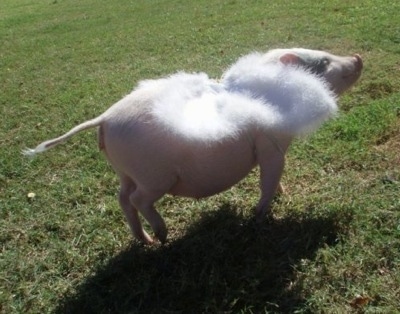
Petunia the pink pot-bellied pig at 8 months old wearing wings
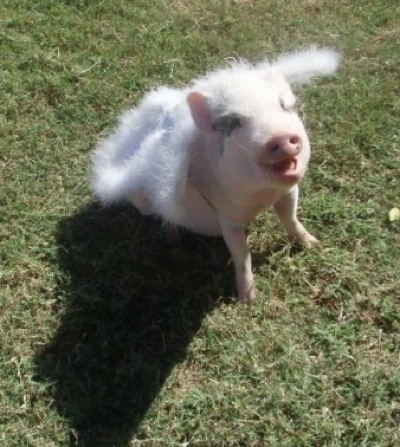
Petunia the pink pot-bellied pig at 8 months old wearing wings
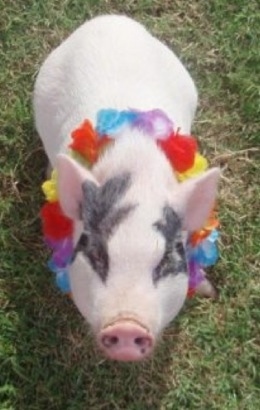
Petunia the pink pot-bellied pig at 8 months old with flowers around her neck
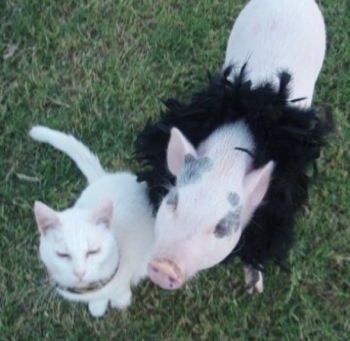
Petunia the pink pot-bellied pig at 8 months old with her cat friend

Petunia the pink pot-bellied pig at 8 months old all dressed up
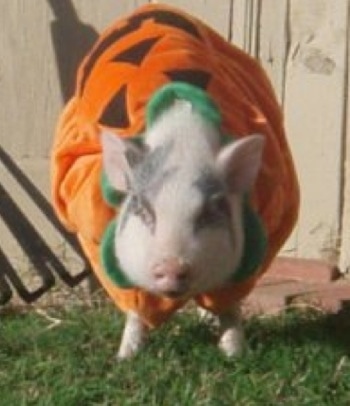
Petunia the pink pot-bellied pig at 8 months old dressed as a pumpkin
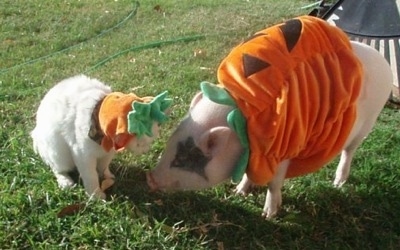
Petunia the pink pot-bellied pig at 8 months old with her cat friend, both dressed as a pumpkin
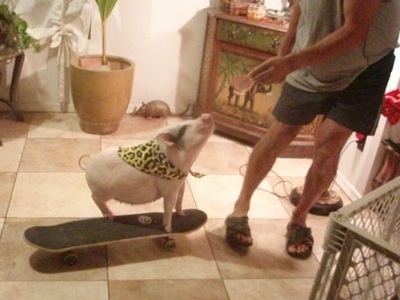
Petunia the pink pot-bellied pig at 8 months old on the skateboard

Petunia the pink pot-bellied pig at 8 months old with her Chinese Crested friend
Pot belly pigs
Pot belly pig
Pot belly pig